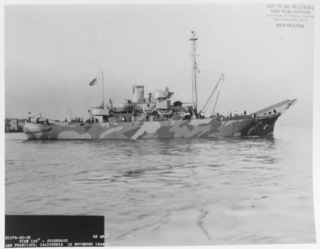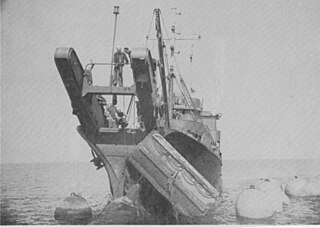
USS Etlah (YN-98/AN-79) was a Cohoes-class net laying ship built for the United States Navy during World War II. She was commissioned in April 1945 and spent her entire career in the Pacific Ocean. She was decommissioned in March 1947 and placed in reserve. She was recommissioned in August 1951 for Korean War service and remained active until May 1960. She was sold to the Dominican Republic in September 1976 as patrol vessel Cambiaso (P207). By 1994, Cambiaso had been removed from Dominican Navy service and hulked.

USS Butternut (AN-9/YN-4/ANL-9/YAG-60) was laid down as a yard net tender on 11 March 1941 at Houghton, Washington, by the Lake Washington Shipyard; launched on 10 May 1941; and placed in service at the Puget Sound Navy Yard on 3 September 1941.

USS Lancewood (AN-48/YN-67) was an Ailanthus-class net laying ship built for the United States Navy during World War II. In service in the Pacific during the war, she earned one battle star. After her February 1946 decommissioning, she was sold to France as Commandant Charcot. Her fate is not reported in secondary sources.
USS Corkwood (AN-44/YN-63) was an Ailanthus-class net laying ship which served with the U.S. Navy in the western Pacific Ocean theatre of operations during World War II. Her career was without major incident, and she returned home safely after the war with one battle star to her credit.

USS Teak (AN-35/YN-30) was an Aloe-class net laying ship which served with the U.S. Navy in the Pacific Ocean theatre of operations during World War II. She was assigned to serve the U.S. Pacific Fleet with her protective anti-submarine nets and earned two battle stars and other commendations for her bravery.

USS Teaberry (AN-34/YN-29) was an Aloe-class net laying ship which was assigned to serve the U.S. Pacific Fleet during World War II with her protective anti-submarine nets and, at war's end, returned home safety with one battle star to her credit. She was later reactivated for duty during the Korean War era.

USS Nutmeg (AN-33/YN-33) was an Aloe-class net laying ship which was assigned to serve the U.S. Navy during World War II with her protective anti-submarine nets.

USS Sandalwood (YN-27/AN-32) was an Aloe-class net laying ship built for the United States Navy during World War II. She was later transferred to the French Navy as Luciole. She was stricken from the French Navy and sold to Malaysian owners, but her fate beyond that is unreported in secondary sources.
USS Mango (AN-24/YN-19) was an Aloe-class net laying ship which was assigned to serve the U.S. Navy during World War II with her protective anti-submarine nets.
USS Mahogany (AN-23/YN-18) was an Aloe-class net laying ship which was assigned to serve the U.S. Navy during World War II with her protective anti-submarine nets.

USS Locust (YN-17/AN-22) was an Aloe-class net laying ship built for the United States Navy during World War II. She was later transferred to the French Navy as Locuste (A765). She was sold to Malaysian owners but sank after striking a reef off Cikobia Island, Fiji, on 30 July 1978. She was towing the former French ship Scorpion, which also sank.

USS Elder (AN-20/YN-15) was an Aloe-class net laying ship which was assigned to serve the U.S. Navy during World War II with her protective anti-submarine nets.
USS Buckthorn (YN-9/AN-14) was an Aloe-class net laying ship built for the United States Navy during World War II. Originally ordered as USS Dogwood (YN-3), she was renamed and renumbered to Buckthorn (YN-9) before construction began in December 1940. She was launched in March 1941, and completed in September 1941. Placed in service at that time without being commissioned, she was commissioned in December 1942, and decommissioned in August 1947. She was placed in reserve in 1947 and scrapped in 1976.
USS Cinchona (AN-12/YN-7) was an Aloe-class net laying ship which was assigned to serve the U.S. Navy during World War II with her protective anti-submarine nets.
USS Chestnut (AN-11/YN-6) was an Aloe-class net laying ship which was assigned to serve the U.S. Navy during World War II with her protective anti-submarine nets.
USS Catalpa (AN-10/YN-5) was an Aloe-class net laying ship which was assigned to serve the U.S. Navy ships and harbors during World War II with her protective anti-submarine nets.
USS Boxwood (YN-3/AN-8) was an Aloe-class net laying ship which was assigned to serve U.S. Navy ships and harbors during World War II with her protective anti-submarine nets.

USS Ash (AN-7/YN-2) was an Aloe-class net laying ship which was assigned to serve U.S. Navy ships and harbors during World War II with her protective anti-submarine nets.
USS Oneota (YN-110/AN-85) was a Cohoes-class net laying ship which was assigned to protect United States Navy ships and harbors during World War II with her anti-submarine nets. Her World War II career was short due to the war coming to an end, but she was retained post-war sufficiently long to participate in atomic testing at Bikini Atoll.
USS Passaconaway (YN-111/AN-86) was a Cohoes-class net laying ship built for the United States Navy during World War II. She was commissioned in April 1945 and spent her entire career in the Pacific Ocean. She was decommissioned in December 1946 and placed in reserve. She was sold to the Dominican Republic in September 1976 as patrol vessel Separación (P208). As of 2007, Separación remained active in the Dominican Navy.










